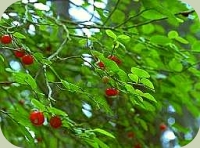Red Huckleberry Plants:
A Valuable Northwest Native

Huckleberry plants can be found hiding in plain sight. Whether you are passing a backyard garden or walking in the forest, massive old growth tree stumps are an integral part of the Pacific Northwest's modern landscape. In many places these old giants act as nursery stumps (a stump that, as it decays, creates detritus which contributes to the formation of rich Humus, providing ideal conditions for plant life to flourish) to a host of other plant life. One of the most common inhabitants of these nursery stumps is the red huckleberry(Vaccinium parvifolium).
Its bright green and thin crooked branches hang laden with pink-red berries early in the spring. These delicate translucent berries have been a source of food for generations of Northwest natives, animals and people alike. They are rich in vitamin C, available sugars and minerals like manganese. Many native tribes of the Northwest collected the berries and either ate them fresh or dried them to make into cakes for use later in the year. Red huckleberries are easy to collect, you simply shake one of the branches and make sure to have a basket or open bag ready underneath. The berries will fall easily from their stem.
As heavily used as they are, not everyone enjoys their tangy-tart flavor. It is for this reason that they are usually combined with other berries, like the blueberry (another Vaccinium of the Ericaceae family) to add sweetness.
Be More Prepared For Your Next Outdoor Adventure!

Don't leave home without knowing these six essential survival skills. Our free survival mini guide reveals the strategies of:
- Shelter & fire to prevent the number one cause of death
- Obtaining clean water to avoid life-threatening dehydration
- Common wild survival foods and other critical skills!

Medicinal Uses for Red Huckleberry Plants
The dried leaves and stems, collected late in the summer to early fall, are medicinally valuable resources as well. According to Thomas Elpel in his thorough book on plants, Botany in a Day, "the berries and plants alike are rich in flavonoids, which are consumed for their antioxidant effects". Further, the Red huckleberry plants are known to be, he says "mildly astringent, diuretic and sometimes act as vasoconstrictors". It is because of these properties that a tea of the leaf and stem are helpful in cases of diarrhea as well as a gargle for sore throats and inflamed gums.
Michael Moore, another leading expert on plants, states in his book, Medicinal Plants of the Pacific West, that "some folks with allergies and the tendency for skin hyperactivity may find that the tea decreases their inflammatory responses".
Whatever it is that first draws you to the red huckleberry plants, I recommend spending some time sitting next to one of them on their big old nursery stumps and taking in all the beauty and bounty they have to offer. See if you can discover who else relies on the huckleberry for sustenance, being sure to return throughout all times of the year.
By the way, when you're out foraging, it's important to know how to stay safe in the outdoors, especially if you were to get lost. Right now you can get a free copy of our mini survival guide here, where you'll discover six key strategies for outdoor emergencies, plus often-overlooked survival tips.
Additional Resources:
Learn about more wild edible plants at our Wild Edible Plants Courses.
Find out more about the natural history of the red huckleberry at Evergreen State College's ethnobotany pages.

About the Author: Kristi Dranginis is an experienced naturalist, herbalist, educator, and ornithologist. She has written articles for the Alderleaf website. Learn more about Kristi Dranginis.
Return from Red Huckleberry Plants back to Wild Plants Articles
Is The Essential Wilderness Survival Skills Course Right for You? Take the "Online Survival Training Readiness" Quiz
See for yourself if this eye-opening course is a good fit for you. It takes just a few minutes! Get your Survival Training Readiness Score Now!

Grow Your Outdoor Skills! Get monthly updates on new wilderness skills, upcoming courses, and special opportunities. Join the free Alderleaf eNews and as a welcome gift you'll get a copy of our Mini Survival Guide.

 The Six Keys to Survival: Get a free copy of our survival mini-guide and monthly tips!
The Six Keys to Survival: Get a free copy of our survival mini-guide and monthly tips!
Learn more